Identify Common Household Pests: use our pest resources section to identify pests you may find around the home, or research a possible pest problem.

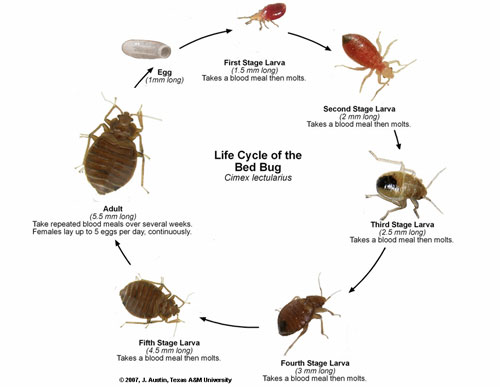
Bedbugs
Description
Bed bugs are parasitic insects of the cimicid family that feed exclusively on blood. Cimex lectularius, the common bed bug, is the best known as it prefers to feed on human blood. Other Cimex species specialize in other animals, e.g., bat bugs, such as Cimex pipistrelli (Europe), Cimex pilosellus (western US), and Cimex adjunctus (entire eastern US).
The name bed bug derives from the preferred habitat of Cimex lectularius: warm houses and especially near or inside beds and bedding or other sleep areas. Bed bugs are mainly active at night, but are not exclusively nocturnal. They usually feed on their hosts without being noticed.
A number of adverse health effects may result from bed bug bites, including skin rashes, psychological effects, andallergic symptoms. Bed bugs are not known to transmit any pathogens as disease vectors. Certain signs and symptoms suggest the presence of bed bugs; finding the adult insects confirms the diagnosis.
Bed bugs have been known as human parasites for thousands of years. At a point in the early 1940s, they were mostly eradicated in the developed world, but have increased in prevalence since 1995, likely due to pesticide resistance, governmental bans on effective pesticides, and international travel. Because infestation of human habitats has begun to increase, bed bug bites and related conditions have been on the rise as well.
Program Overview
Bed bugs are blood-seeking insects known for infesting areas where people and animals sleep, and are a growing problem in North America, particularly in areas with large or transient human populations, such as apartment buildings, hotels, cruise ships and dormitories. Their bites cause itchy red welts, skin infections and allergic reactions as a result of the saliva they inject when they feed.
Notoriously hard to detect, bed bugs hide in bed frames, mattresses and box springs, clothing, luggage, furniture, book bindings, behind baseboards and under wallpaper. They are difficult to eradicate and don’t have a preference for dirty or clean areas – they are as likely to show up in a five star hotel as they are to take up residence anywhere else.
Prior to our arrival, we’ll present you with a series of bed bug treatment preparation steps, such as removing bedding. From there, a series of bed bug elimination tactics are employed.
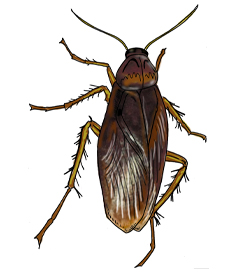
Cockroach
Description
A common pest worldwide, cockroaches cause trouble by carrying various bacteria, protozoans and viruses into homes. Aside from compromising the health of people in infested buildings and households, the insect is known to spoil large amounts of food through contamination.
Appearance
What Do They Look Like?
Size: Adult cockroaches reach lengths of 1/2 an inch (12.7 mm) to 1-1/2 inches (38.1 mm) long.
Color: Light to dark brown, reddish-brown
Characteristics: Generally, cockroaches have flat or oblong bodies. Most species of cockroaches have wings that either cover the length of, fall short of or extend past the abdomen. Some cockroaches also have distinguishing markings such as two parallel lines on the shield-like pronotum or a yellow border on the thorax and wings.
Geographic Range
Many cockroaches thrive in tropical climates but are found throughout the world. Though more prominent in subtropical areas, the insects were brought to the north in ships and similar modes of transportation that carry imported food.
Food
What Do They Eat?
While specific dietary needs differ between species, decaying organic matter represents a significant food source for the insect. Specifically, cockroaches feed on starches, sweets, grease, garbage, meat products, glue and paste, dead skin particles, wallpaper, book binding and more.
Biology
All cockroach species go through three stages of life: egg, nymph and adult. Most female cockroaches lay eggs in a protective capsule which may contain anywhere from 13 to 48 eggs depending on the species. After carrying the capsule around on her abdomen for a species-specific amount of time, the female deposits the egg capsule in a protected location preferably near a food source. The egg stage of the cockroach life cycle lasts from less than one month to almost a year in duration. German cockroaches who complete the life cycle the quickest, produce more eggs at a time and therefore pose significant problems for Mid-Atlantic homeowners and live longer than seven months as adults.
Detection
- May notice a foul odor given off by large infestations.
- Look for excrement, skin casts and empty egg capsules in crevices close to the ground.
- Examine basements, crawlspaces, sinks, and bathtubs for leaky pipes and fecal smears.
- Check electrical areas for live cockroaches, skin casts and feces.
Problems Caused by Cockroaches
Cockroaches bring many health risks into the home. Aside from being unpleasant, the odorous secretions given off by the insects contaminate any food supply from which the insect feeds. Cockroaches also carry bacteria, protozoans and viruses on their bodies. Humans often contract food poisoning, dysentery, diarrhea and other unpleasant conditions resulting from the existence of cockroaches in the home. Additionally, the insect’s excrement and skin casings contain allergens which may cause affected individuals to contract skin rashes, experience congestion and become watery-eyed and sneezy. Furthermore, cockroaches contribute to the development and irritation of asthma. Lastly, as many species of cockroaches prefer warm and dry or moist environments, the insects may cause damage to machines or piping.
Signs of Infestation
Although the behavior of each cockroach species is different, there are several universal signs of infestation. The pest is nocturnal by nature and usually forages for food at night. Spotting a cockroach during the day therefore indicates an infestation of some magnitude. Due to their flattened bodies, cockroaches are able to hide in tiny spaces. Because the insects usually prefer dark and warm environments, homeowners and residents should keep an eye on areas behind and inside major appliances, floor drains, behind wallpaper and within walls.
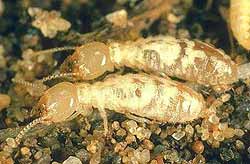
Termite Prevention Services for Your Home
Termite Pest Control Program Overview
What’s the best way to handle termites? Thrasher offers a liquid barrier using Termidor and Taurus. With Thrasher’s Defense Program, the “treated zone” allows the termite to either ingest or carry the termiticide directly to the colony. This leads to 100% control in less than 120 days. Thrasher prides itself on being the leader in innovative pest control techniques and taking that extra step to insure a first quality job!
This program offers a full liquid treatment around the perimeter of the house. Liquid treatment is then followed up with targeted interior treatment within problem areas.
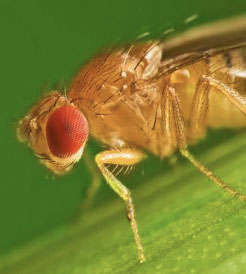
Fruit Flies
Drosophila melanogaster is a species of small fly. Adults are 3 to 4 mm long, may have red eyes, though some are dark eyed, and a tan thorax. The abdomen is black on top, gray underneath. Fruit flies can appear to be brown or tan in color.
Behavior, Diet & Habits
Populations tend to build during the summer, becoming very abundant at harvest time. Indoors, fruit flies are frequently active at all times of the year.
Fruit flies eat ripened fruit and vegetables and fermenting products. Ream more about fruit flies in food.
Reproduction
Larvae of fruit flies develop in moist areas where organic material and standing water are present. The entire life cycle lasts 25 days or more depending on the environmental conditions and the availability of food.
Signs of a Fruit Fly Infestation
The two most visible signs of fruit fly activity would be the adult flies and the pupae. Adult flies often are seen flying around in kitchens or trash cans near the decaying fruit or vegetables. They also are attracted to liquor and liquor/beer bottles. The mature larvae of fruit flies crawl out of the breeding material to pupate in a dry nearby spot. They sometimes are mistaken for cockroach or rodent droppings but can easily be differentiated by a pair of horns on one end of the pupae.
Fruit Fly Facts
There are over several known fruit fly species across the globe. Like other fly species, fruit flies experience a four-stage life cycle: beginning as eggs, they undergo larval and pupal stages before emerging as adults. The early life stages span approximately a few days and fruit flies can complete their development in as little as week in ideal temperature conditions. Adult fruit flies can live up to 30 days.
The common fruit fly (Drosophila melanogaster) is known for its ability to reproduce rapidly. The common fruit fly is a useful specimen in scientific research. The rapid life cycle allows researchers to study the effects of an experiment over a number of generations. Mutations are also common and easily followed in this fly species. Fruit flies have only four pairs of chromosomes: three autosomal pairs and one pair that determines sex. The entire compact genome of the common fruit fly was sequenced in 1998.
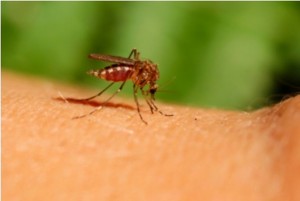
Mosquito
Description
Most of the time, mosquitoes are not much more than the cause of itchy welts and minor discomfort, but they can also cause serious illness. Prevalent throughout the United States, they can cause several types of disease, including West Nile Virus, perhaps the most common mosquito-borne illness in the U.S.
Typically surfacing in late summer and early fall, West Nile is caused by mosquitoes feeding on infected birds, and then passing the virus to humans and other animals through the saliva they inject with their bites. Traveling through the bloodstream to the brain, the virus interferes with the central nervous system and causes swelling of the brain tissue. For most people, the illness is mild and causes fever, headache, and fatigue. In more severe cases however, encephalitis, meningitis, paralysis, or even death can occur. For those with even just a mild case, it can take several months to recover.
Mosquito-Borne Diseases
Prevalent throughout the United States, mosquitoes cause several types of disease including West Nile Virus, encephalitis, dog heartworm, and malaria. World-wide, mosquitoes are responsible for more human deaths than any other pest.
West Nile Virus
Typically surfacing in late summer and early fall, West Nile is caused by mosquitoes feeding on infected birds, and then passing the virus to humans and other animals through the saliva they inject with their bites. The virus travels through the bloodstream to the brain where it interferes with the central nervous system, causing swelling of the brain tissue. Symptoms are typically mild and include fever, headache, and fatigue, but severe cases can develop into encephalitis, meningitis, paralysis or rarely, death. West Nile is typically mild, but it can take a person several months to recover. Other viruses spread by mosquitoes include malaria, yellow fever, and dengue fever, all of which are rare in the United States but common in tropical areas around the world.
Moisture
After any warm winter,spring bug populations will have a strong start – and all it takes is a little moisture to kick start a mosquito infestation. Sal Presti, Western’s NY/NJ Regional Sales Manager offers some tips:
- Water = mosquitoes: Walk your property from the woods to the street, and look for any and all sources of standing water.
- Drain it: Anything that can hold or retain water needs to be drained and turned upside down, Presti reminds homeowners. From old tires on a property to standing flower pots, they need to be drained or removed.
- Don’t forget the bird bath: “I love bird baths…they look great, but it’s a mosquito swimming pool,” Presti says.
Prevention, then Intervention
Although it is common practice to spray for mosquitoes, spraying pest control materials is not the most effective means of controlling a mosquito outbreak. It is far more effective to prevent them from breeding in the first place. Mosquitoes lay hundreds of eggs at a time and gestation only takes about seven days. If they find standing water to breed in, it could mean several generations of mosquitoes in your own back yard.
Prevention Tips
There are several simple things you can do to minimize the risk of mosquitoes in and around your home, particularly if you have a pond or other water feature.
- Keep water fixtures such as birdbaths and fish ponds clean, and add elements that keep the water moving, such as a fountain if possible.
- Clean gutters regularly to avoid trapping water and creating areas where mosquitoes will potentially breed.
- Work to attract natural mosquito predators, such as dragonflies.
- Try keeping guppies or mosquitofish in your pond as they will eat the mosquitoes and their larvae.
- Maintain your lawns and gardens. Overgrown areas trap moisture where mosquitoes are likely to nest.
- Regularly drain and clean (or remove) things that hold water: pet dishes, wading pools, vases, or anything that may collect water, such as old barrels.
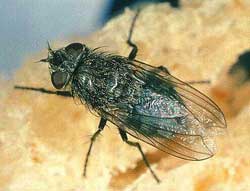
Flies
Description
Approximately one million species of flies inhabit the world. Since they are such diverse insects, fly infestations can be hard to manage as identification is necessary for proper removal. The most common species residing in our service area include cluster flies, house flies, moth flies, scuttle flies, and vinegar flies. Unclean and associated with disease and decay, flies are known carriers of about six million different bacteria externally and 25 million internally.
Appearance
What Do They Look Like?
Size: The house fly is the most abundant species and grows 1/8 to 1/4 of an inch long. While some species grow slightly larger than house flies, most species are tinier. Almost no existing flies measure over an inch in length.
Color: Most species are darkly colored, ranging from grayish-black to lighter gray, though some species appear yellowish-brown to dull yellow.
Characteristics: Universal characteristics include a single set of wings, six legs, and mouthparts ideal for sucking or sponging. Some common species feature bright red eyes, hair covering their bodies, and markings along their thorax.
Geographic Range
Found throughout the world on every continent, including Antarctica, flies generally hold a cosmopolitan distribution and live wherever there’s human activity. While the most common species tend to thrive in moist and warm environments, flies are capable of surviving for some time in cold weather. Furthermore, the pests are capable of finding food sources most anywhere due to their flexible diets.
Food
What Do They Eat?
Flies earn their reputation for uncleanliness largely because of their diet. The insects feed on garbage, animal feces, carcasses, carrion, food wastes, and various other decaying and putrefying organic materials. As a result, flies spend significant amounts of time in sewers and dumpsters.
Biology
Flies begin as eggs and develop through larval and pupal stages before reaching adulthood. Though life cycle time frames and ideal conditions differ by species, most flies deposit their eggs directly into food sources. House flies, for example, prefer to leave their eggs in horse manure, while cluster flies deposit eggs into areas of soil rife with earthworms, which serve as host animals for the parasitic species. Fly larvae are commonly referred to as maggots and molt several times before reaching the pupal stage. It can take flies anywhere from one to three weeks to reach full maturity, and they tend to survive several months at most.
Detection
- Look for the presence of adult flies around the house
- May notice tiny dark spots of excrement on walls, counters, windows, or food
- Be alert for household occupants developing prolonged or frequent cases of diarrhea
Problems Caused by Flies
The most serious problem associated with fly presence is the spread of diseases. When flies land on any surface, including food ready for human consumption, they secrete liquids from salivary glands and defecate, which often results in disease transmission. Flies can carry diarrhea, dysentery, E. coli, anthrax, cholera, leprosy, polio, rotavirus, and salmonella. Additionally, houses infested with flies are stigmatized as uncleanly.
Signs of Infestation
Consistent sightings of adult flies around the house usually means an infestation is present. The existence of overripe fruits, rotting bags of potatoes or onions, easily accessible trash, or sewage leaks in addition to adult fly sightings almost certainly indicates fly problems. Depending on the species, homeowners may find clusters of overwintering flies around windows on sunny winter days, dark and tiny spots of excrement on windows, counters, and walls, or heightened illness among members of the household.
Prevention Tips
The two most effective methods of fly prevention are sanitation and exclusion. Sanitation involves limiting food sources. Make sure all indoor and outdoor trash bins have tight lids. Do not let manure, grass clippings, weed piles, or other decaying organic materials accumulate. Clean drains and sewage pipes frequently. Finally, remove overripe fruits and rotting tubers as soon as they start to spoil. In order to exclude flies from the premises, homeowners should install window and door screens, caulk or plug cracks in walls and foundations, and find adequate screening for ventilation holes.
Tips for Removal from Home
If flies have already infested a home, the help of a pest control professional is typically needed. Targeting the food sources and probable harborage sites of flies is integral to effective removal of infestations. As professionals have knowledge of the habits of various fly species, they are the only people equipped to efficiently eradicate infestations of the pest.
Fly Prevention: Keep Flies Away
With flies, prevention starts outside by eliminating areas where they tend to breed and then using simple methods to keep them out of your house:
- Put a lid on it: Flies love the allure of rotting garbage. It not only provides ample food, but is a great environment for breeding.
- Scoop the poop: Keep your yard clear of animal feces by making “poop patrol” a consistent – and frequent – household maintenance task.
- Leave ’em high and dry: Eliminate sources of pooling water to avoid creating stagnant patches of water where flies will breed.
- Cover your drains: Indoors and out, make sure drains are kept clean and fly-free.
- Seal up: Apply caulking to cracks around windows and doors, and ensure that your screens fit properly and are free of rips and holes.
- Trap those that remain: As a last resort, fly paper and electric light traps can kill flies that manage to bypass your prevention efforts. These can be unsightly. Consider a classic fly swatter as your best bet against any stragglers.
Hidden Dangers of Flies
Most of us don’t think of flies as much more than annoying bugs that require an occasional swat and good screens on the windows to keep them out of the house. But they can cause bigger problems than an irritating buzzing noise, potentially carrying diseases such as tuberculosis, typhoid, dysentery, diarrhea and other kinds of food borne illnesses.
Fly dangers and health hazards
The mechanics of how flies spread disease isn’t pretty. They frequent areas where they can find rotting garbage and human or animal waste, and then carry germs from those areas to the food we eat. Flies actually vomit and leave excrement on what they eat so between what they carry on their bodies and what they leave behind from within their bodies, taking necessary precautions to keep flies out of your home and food is well worth the effort.
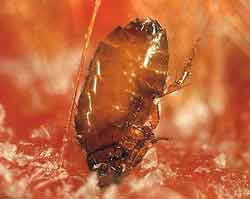
Flea
Description
Fleas are ectoparasites that target both avian and mammalian hosts. Over 2,500 known species populate various areas around the world. Some of the most notable species include the cat flea, dog flea, and the northern and oriental rat fleas. Cat fleas are actually the most common parasites of both cats and dogs, as dog fleas are rare in North America. Fleas pose health concerns for both pets and humans.
Appearance
What Do They Look Like?
Size: How big are fleas? Minuscule and hard to see with the naked eye, adult fleas range in size from 1/8 to 1/4 of an inch in length. They have complete metamorphosis so they do not molt after becoming adults.
Color: Fleas vary from dull reddish-brown to dark reddish-brown in color and appear darker after consuming a blood meal.
Characteristics: Wingless and hard-bodied, fleas use their extremely narrow girth to navigate through the hair, fur, or feathers of host animals with ease. The pests have large hind legs that facilitate impressive lateral jumping abilities and mouthparts ideal for piercing and sucking.
Geographic Range
Fleas are found around the world and can typically survive anywhere suitable hosts also exist.
Food
What Do They Eat?
Like most parasites, fleas survive on a diet of blood and must consume a meal at each stage of development to reach maturity. Flea larvae eat what is called flea dirt, which consists of dried feces of adult fleas.
Biology
The life cycle of a flea can take as little as two week or as long as eight months to reach completion depending on the temperature, humidity, and available food. Female fleas lay up to 600 eggs in their lifetime and deposit approximately 15 to 20 eggs at a time directly onto a host. While some eggs inevitably fall off during the everyday activities of the host animal, the surviving eggs hatch within two weeks.
Flea larvae pass through three instars and need at least one blood meal before weaving a cocoon in which they pupate and develop into adults. Newly mature fleas only live about a week without a meal, but after the initial feeding, adults can survive for two months to several years without eating.
Detection
- May notice pets scratching at their necks, shoulder blades, and the base of the tail with more frequency.
- Check for black excretion pellets and adult fleas in pet fur.
- Look for small, hard, red spots with red halos, particularly on the ankles and legs of household members.
Problems Caused by Fleas
Both humans and common household pets have adverse reactions to the salivary secretions released by fleas when feeding. The intensity of the reaction ranges from mild irritation and rashes to anemia in extreme cases. Fleas also carry tapeworm eggs that are easily transferred to cats and dogs. Additionally, fleas may carry serious diseases like the bubonic plague and Murine typhus.
Signs of Infestation
Due to their miniscule size, adult fleas are difficult to spot without a microscope or knowledge of what to look for. Typically, humans are alerted to a flea infestation by the way their pets behave. If the animals are scratching with more regularity, especially at their necks, shoulder blades, and at the base of their tails, it could be a sign of flea infestation.
Bathing pets and combing through the fur to look for black pellets or adult fleas is the best way to confirm the presence of the pests. Furthermore, as fleas are known to feed on humans while they sleep, a breakout of small, hard spots that are swollen and red along the ankles and legs indicates flea activity.
Prevention Tips
Measures can be taken to make the home environment less attractive to fleas. Regularly trim lawns and vacuum homes. Monitor or restrict pet activity so they are less likely to come across an infested area or animal. Trim tree branches and take other precautions to discourage the nesting of flea-ridden birds. Track down and fix any cracks in building foundations or broken screens, and regularly wash pets and their bedding.
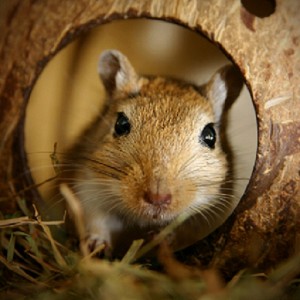
Rodent (Mice & Rats)
Rodent Control: Why You Need to Exclude Now
The thought of a four-legged pest scurrying across your kitchen floor should be incentive enough to invest in some time learning how to exclude rodents now and not wait until it is too late. Rodent problems can quickly become unmanageable and pose a threat to a homeowner’s health and quality of life. From tracking salmonella and Hantavirus to damaging food items, wires or insulation, there are several negatives of a rodent infestation. This simply reinforces the need for exclusionary tactics. Smart prevention and the help of a professional rodent control expert can help to make rodents a non-issue this winter.
First things first…
The calling cards of a rodent infestation are important to understand so that you know exactly what to look out for as rodents start making their way indoors in search of warmth and sustenance.
- Droppings: Rodents leave behind fecal droppings around 70 times per day. That’s certainly something that should catch a homeowner’s eye. Look in food and storage areas where rats and mice tend to hide.
- Urine Trails: Mouse urine has the ability to cause allergies in some children. These can also attract more mice often found along the walls or the floor.
- Gnaw marks in food containers: This is a sure-fire sign that your home is experiencing some type of rodent infestation.
The best way to avoid having to seek out rodent calling cards in the first place? Exclusion. When rodents can’t get in, they can’t cause problems, and this should be a key aspect of your home maintenance plan this season.
Prevention Tips
If your rodent problem is already out of control, consider hiring a professional pest control company such as Western Pest Services to send overwintering guests packing. From patented Watchdog™ and Mouse House™ monitors to fast removal, we’ll help you quickly get the toughest pest problems under control.
* If you do happen to find a hole or gap throughout your property, be sure to use a sealant that is rodent-proof. This will ensure that they do not gain or regain entry.
- Look for entry points. Diligently inspect the exterior of your home for any gaps or holes. A rodent can sneak into your home through a hole that is as small as a nickel, so make sure to check closely.
- Seal your food properly. Rodent-proof containers like plastics bins and metal canisters are an effective means of making sure your food is not contaminated by a potential rodent issue.
- Remain vigilant: Be on the lookout for droppings, wall markings, damaged packaging or actual pests.
- Create barriers: Keep food and drinks tightly sealed in rodent-proof containers such as plastic bins and metal canisters.
- Sweep away crumbs: Rodents aren’t picky. Keep a tidy home and wipe up any and all food spills immediately.
- Search for entry points: The smallest opening can lead to big rodent problems so inspect your property regularly.
- Clear clutter: Every rodent wants a nice place to hide and excess cardboard and other such materials make perfect nests.
- Check your kitchen for hidden entry points. Rodents are most likely to be found here so search behind appliances within cabinets and pantries.
- Don’t forget storage areas. Crawl spaces, attics and basements tend to fall to the wayside when it comes to home maintenance, but you should certainly check these now for potential access points.
- Eliminate harborage. Make sure woodpiles are kept a safe distance from the house. These become harborages for rodents in the winter time.
- Clean up! Clear up debris and clutter throughout your property, not just on the inside of your home.
Rodents shouldn’t be given the chance to enjoy your warm and comfortable home with you this winter. Knowledge and exclusion will ensure a safe, pleasant, rodent-free winter and holiday season for you and your family.
As cooler weather approaches, we all begin to migrate indoors and spend less time outside. Unfortunately, cold weather and long nights also bring unwanted houseguests who move indoors to escape the elements. A few hours spent excluding access to your home from wintering rodents can save you the worry of having to deal with them in your house later on.
Rodents Leave Calling Cards
Rodents, particularly mice, can create some angst during the cooler months, as they move into walls, closets, pantries, linens and furniture seeking warmth and food. In some cases, they can appear in large numbers particularly if their normal resting places have been disturbed. Discretion is not their forte as you can typically find evidence of their existence through droppings, urine trails, gnaw marks on food boxes and scampering and rustling sounds particularly at night.
As cute as they may be (or as cute as some of you might think they are), rodents present serious health risks as they can carry a variety of diseases such as the potentially fatal Hantavirus. Rodents can also transport bacteria such as salmonella into your food.
An Ounce of Prevention
Food and water are the primary draw for rodents moving in, and in homes that sit near large water sources they can be a particularly bad problem. It would be very difficult to remove food from your home, but there are steps you can take to seal food in containers that are rodent-proof such as plastic bins and metal canisters.
One step that goes a long way in preventing rodents from getting into your home is inspecting your property for gaps and holes where rodents can enter. Mice can squeeze through holes the size of a nickel, so be sure your inspection is thorough. Start with the kitchen by looking behind cabinets and appliances, but also check closets (especially the corners), around doors, under sinks, around drains and where floors and walls join together. Don’t forget about crawl and attic spaces as well.
You’ll need to seal holes with materials that rodents can’t gnaw through such as hardware cloth, cement or metal sheeting. Seal any gaps or holes the size of a pencil or larger with plenty of caulking or other sealant product.
You can also do things around your property to discourage rodents from establishing themselves. Keep nesting materials and harborage sites such as woodpiles and thick vegetation away from your house. Your property should also be kept free of debris, rocks and logs that mice can make their homes. Other things to look out for include old cars and appliances which should be hauled away.
As an added precaution, you may want to consider placing mouse traps strategically around your home to catch any rodents that do happen to find their way inside. Clean up dead mice and any droppings or urine they leave behind with care, using latex gloves and a face mask. Anytime you handle dead mice or their droppings, you should consider the possibility of disease transmission. Hantavirus is one of the most serious diseases that can occur with rodent contact due to the severe respiratory distress it causes.
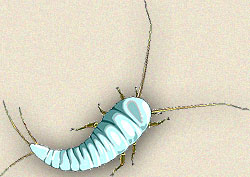
Silverfish
Description
As the name implies, silverfish are silver or gray insects that move from side to side in a manner that resembles the motions of a swimming fish. These cosmopolitan pests are found throughout the United States. They prefer habitats around room temperature with high humidity and are known to feed on a variety of foodstuffs. A nuisance pest, silverfish can be quite annoying in libraries, museums, and homes, as they feed on paper and the glue in book bindings.
Appearance
What Do They Look Like?
Size: The common silverfish is about 1/2 an inch in length, but may grow as long as 3/4 of an inch.
Color: Deriving its name from the color of its body, the silverfish typically appears shiny silver or pearl gray.
Characteristics: Slender, flat and “carrot shaped,” the silverfish body gradually tapers from the front to the rear where a trio of long, thin, tail-like appendages extend. The insect also has two long antennae which, when combined with the tail appendages, nearly equal the length of the body. Nocturnal by nature, silverfish are fast-moving but do not possess wings for flight.
Geographic Range
With a worldwide range, silverfish can be found throughout our primary service area in the Mid-Atlantic region of the United States, as well as the rest of the country.
Food
What Do They Eat?
Silverfish can go for long periods of time without nourishment. When the pests eat, they tend to prefer foods high in carbohydrates and protein, such as cereal grains, dried meat, dead insects and, at times be cannibalistic on their own. In the home, silverfish may attack and eat synthetic fabrics, silk, the glue contained in book bindings or wallpaper, and paper products.
Biology
Silverfish lay their eggs in cool, moist, and dark places, such as cracks, crevices, and other narrow spaces near sources of food. Each female lays between 1 to 3 eggs per day which hatch into nymphs that look similar to adults.
The specific length of time between birth and adulthood depends on various environmental factors such as temperature, humidity, and food availability. Silverfish nymphs molt up to many times a year, and maturation may take anywhere from three months to three years. Silverfish are long-lived insects, with adults enjoying a lifespan of up to three years.
Detection
- Look for silverfish in basements, storage areas, closets, and crawl spaces.
- May notice holes at irregular intervals in books or wallpaper, sometimes accompanied by yellow staining.
- Remain alert for tiny fecal matter that looks like specks of pepper.
- Silverfish are often found in areas of high moisture, including bathtubs and sinks.
Problems Caused by Silverfish
Primarily just a nuisance, silverfish are not known to transmit any diseases or cause structural damage to homes. For the most part, homeowners, museum workers, and librarians detest the creature because of its appetite for books, paper, and similar artifacts. In these situations, damages can be costly, especially if rare or antique pieces are fed on. Though rare, the accumulation of dead silverfish and their scales may lead to allergic reactions, as well as provide a food source for the damaging carpet beetle.
Signs of Infestation
Outside of seeing the insects scurrying from place to place indoors, the most common sign of a silverfish infestation is the damage they inflict upon book bindings, wallpaper, and certain fabrics found around the home. The emergence of small, unconnected, and irregular-shaped holes and staining may hint at the presence of the silverfish.
Prevention Tips
As silverfish prefer dark and moist hiding places, eliminating their favorite environmental conditions can help prevent the insects from infesting. Reroute drainage away from the home to reduce damp conditions in basements or crawl spaces, keep interior floors clear of debris and use a dehumidifier to lower the relative humidity within the structure. Keep all dry goods in properly sealed containers, and store books in a moisture-free environment.
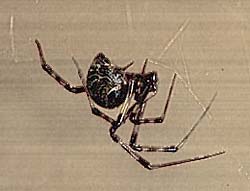
Spider
Description
Over 40,000 species of spiders exist around the world, with more than 3,000 found in the United States alone. Due to their numbers and diversity, spiders resist traditional classification. Spiders can be identified down to the family level fairly easily by pest management professionals; however, it takes a trained taxonomist to identify them down to species. To make pest control easier, professionals organize spiders into one of four broad categories: burrowers, web-spinners, active hunters, and sit-and-wait ambushers. Over 20 species of web-spinners and active hunters are potential pests to Mid-Atlantic homeowners and residents.
Appearance
What Do They Look Like?
Size: Due to the sheer variety of species, spiders tend to resist generalizations about appearance. Mid-Atlantic spiders may remain as small as 1/5 of an inch (5.08 mm) or grow as large as an inch (25.4 mm) or more in length. Perhaps the only universal rule of spider size is that females are significantly larger than males.
Color: Spiders range in color from black to white. Rarely solid in color, the pests tend to have different colored markings along their legs, abdomen, and cephalothorax. Frequently, spiders appear brown with darker brown patterns, black with white markings, yellow and black, reddish brown, and so forth.
Characteristics: All spiders have two main body sections: the abdomen and the cephalothorax. Each spider also possesses eight legs, which protrude from the body. Additionally, all spiders have mouthparts; chelicerae, or pincer-like appendages; eight eyes, which are arranged in various ways that can be used as a means of family identification; fangs and venom glands; and spinnerets, which are the silk-spinning organs of spiders.
Geographic Range
Spiders have the capacity to survive in most environments on the planet. They are found on every continent and even dwell in shallow freshwater. Extreme cold is the only environmental element spiders cannot withstand.
Food
What Do They Eat?
Spiders are considered predators. Their diet consists of insects, other spiders, and various invertebrates. Some especially large species will attack smaller vertebrates, such as lizards and frogs. Though people often find the arachnids unnerving, spiders remain beneficial to humans because of what they eat. Various outdoor pests serve as a staple in a spider’s diet, therefore, potentially reducing the number of pest we encounter.
Biology
The various species of spiders each have unique reproduction habits and lifespans, though some consistencies exist. Typically, female spiders live longer than males. Lifespans range anywhere from several months to as long as seven years. Spiders tend to mate between late spring and mid-summer. Females deposit eggs in sacs or cocoons and produce anywhere from 30 to over 1,000 eggs at a time, depending on the species. Many species require several rounds of molting before reaching maturity.
Detection
- Look for spider webs inside and outside the home
- May spot adults scampering across the floor
- Look for egg sacs and cocoons located near spider webs
Problems Caused by Spiders
While spiders actually do more good than harm to homeowners, some species are venomous, though most lack strong enough “jaws,” or chelicerae, to puncture the layers of human skin necessary to cause serious damage. Nevertheless, many people suffer from arachnophobia, and the presence of spider webs carries a stigma of uncleanliness. As such, pest management specialists often respond to the need for elimination.
Signs of Infestation
Typically, spiders do not congregate in large numbers, which makes infestations a rare occurrence. Active hunters and web-spinners are the two types of spiders most commonly found in the Mid-Atlantic region, where they enter homes to search for food. As a result, homeowners may spot webs inside and outside the house in gardens, woodpiles, attics, and basements. Residents may also find adult spiders climbing on walls or running across the floor in search of insects. Finally, some species of web-spinners and active hunters will leave egg sacs and cocoons inside the home. As spiders tend to produce hundreds of eggs at a time, the sacs and cocoons generally suggest the presence of a large population of the arachnids in the home.
Prevention Tips
As spiders rarely enter homes in the first place, homeowners need only heed simple preventative measures. Controlling the level of humidity in attics, basements, and other dark areas of the home deters spiders from settling. Sealing or caulking points of entry, like cracks in the foundation or around doors and windows, helps deter their ability to get inside. Cleaning up woodpiles and other attractive hiding places outside further reduces the chances of finding spiders in or near the home. Lastly, removing outside webs and changing outdoor lighting reduces the availability of prey, which compels spiders to look elsewhere for food.
Tips for Removal from Home
If spiders have already moved in, Mid-Atlantic homeowners enjoy several easily executed options for removal. Vacuuming, for example, is an effective means of elimination. Adult spiders, eggs, and webs can all be vacuumed up, and the dust inside vacuum bags quickly suffocates adults. As unnerving as people may find the prospect, capturing and releasing spiders outside the home is also an effective method of sending the pests on their way. As a last resort, people may turn to insecticides or pesticides. Homeowners who have reached the need for chemicals, or who suffer from black widow or brown recluse spider infestations, should contact a licensed pest control specialist.
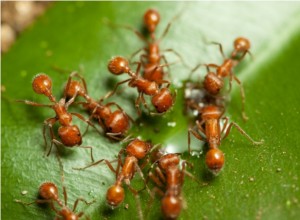
Ant
Ant Pest Control Service
Whether battling odorous house ants and pavement ants or seeking to prevent carpenter ant damage, ant control in the house is often attempted as a DIY project. However, effective ant control often requires the knowledge of the target ant’s activities, habits and habitats. Many ant species come and go in predictable cycles, and homeowner efforts to fend them off can often be ineffective and time consuming. In fact, used at the wrong time and in the wrong situations, ant traps can attract the very ants they’re designed to prevent, in the worst cases encouraging nesting inside the home.
Luckily, you don’t have to live with ants. Western provides proven ant control with asatisfaction guarantee as part of our comprehensive Home Protection Plans.
Ant Control in Your House…and Outside, Too
Household ant problems often start outdoors where landscaping, cracks, and gaps attract these pests and then provide entry inside. Western’s Home Protection Plan safeguards your home through a combination of three seasonal visits and free emergency-response visits should issues ever arise. That means you’re protected from ant problems all throughout the year.
Carpenter Ant Control that Prevents Damage
Carpenter ants can cause extensive damage to your home, which makes fast action essential upon detection. Found in moist or decaying wood, carpenter ants cut galleries into wood to create passageways and nesting sites, and they can ultimately impact the stability of wooden structures if left untreated. At their largest, carpenter ants can be up to an inch long, and at the first sighting it’s wise to take action.
To help you combat potentially expensive repairs, Western adds guaranteed carpenter ant control as part of our Home Protection Plus (HPP+) program.
Prevention Tips
Ants are hardy bugs, having been around for millions of years and existing in various forms all over the world. Given their longevity and adaptability, is it any wonder that they are so persistent and difficult to get rid of? Try some of our tips to keep ants at bay.
- Sweep and mop: Keep floors swept and clean. It takes very little in the way of food particles to attract a veritable army of ants.
- Lock it up: Store food kept on counters or open shelves in air-tight containers or you’ll soon find ants in your sugar bowl.
- Clean up after yourself: Don’t leave dirty dishes unwashed – if you leave them out overnight, expect to find visitors in the morning.
- Get Fido on board: Ensure your pets’ food bowls are kept clean and that food does not sit out once your pet is done eating.
- Spic and span: Clean up spills quickly and with a bit of dish soap to naturally deter ants.
- Sanitize your trash: Keep garbage cans and outdoor refuse areas clean of crumbs and spills.
- Clean up spills immediately
- Reduce moisture in your home
- Keep bushes and plants trimmed away from your home/roof
- Replace any mulch against your home with pea gravel
- Re-caulk windows and doors as needed
- Find moisture sources: Conditions conducive to water build-up can attract ants…and many other pests as well. Check for standing water outside, and for leaks indoors.
- Move winter wood piles: Wood or wood-based products should be stored at least a foot away from the home. An infestation in a wood pile can quickly become an infestation in a home.
- Mind your mulch: “Mulch looks great, but it’s a harborage for many insects.”
Problems with DIY Solutions for Ants
Unbeknownst to many homeowners, the ant traps you’re using could very well be attracting the very pest you are trying to avoid. Many people find an ant on their kitchen counter and immediately think to use DIY-solutions throughout their indoor property. Something to keep in mind before doing so is the fact that many ant populations begin outdoors and can end up nesting indoors.
Felicia Gogol, Western’s Branch Manager of Monmouth County and Princeton, NJ office reveals, “Homeowners buy what they think is a solution from the store, try it themselves, and end up calling us afterward. You want to bait more outside and professionals are the best suited in discovering where exactly to do the work.”
Seasonal Activity
Unfortunately, they’re a common summertime pest that many homeowners must deal with. Spotting them marching along your kitchen counter or near your sink is unsettling, both from a sanitary and aesthetic standpoint. As the summer continues, ant populations will continue to grow with it, meaning that homeowners should be on the lookout now, before populations become too large to handle.
“We tend to see more ants in the summer because all of the food and water they’re taking from us, they’re putting into their brood. This allows populations to grow bigger and bigger as the summer goes on.” Hope Bowman, Technical Specialist,
Summertime Ant Species
- Pavement Ants
- You may notice this summertime nuisance when venturing outdoors for BBQs and outdoor parties.
- What can you do?
- Just like mosquitoes, these ants are attracted to standing water. Eliminate moisture throughout the house and outdoor area, and your property will work harder to prevent pavement ants.
- Odorous House Ants
- This is the ant you’re bound to discover along your kitchen counter or bathroom sink.
- What can you do?
- Check for holes or gaps in screens throughout the house. This will allow these small critters to get indoors.
- WARNING! Try to avoid crushing these ants. A rotten, coconut-like scent is emitted when they’re killed.
Different Ants Require Different Forms of Ant Control
“No one should treat for ants before positively identifying the species,” says Paul Filardo, Residential Sales Manager. “Ant control is really about locating the nest and then focusing on exclusion…but sometimes ants look very similar, so it can be hard to tell for sure.”
Filardo points to carpenter ants and pavement ants as an example. Both are ants, but have different behaviors. While pavement ants are a nuisance, carpenter ants can cause serious damage to homes as they bore galleys into wood structures. Often, they nest in tree stumps near the home…or even in your walls. Other common ants in the area include odorous house ants – sometimes mistaken for sugar ants – and acrobat ants. The latter are common to South Jersey and nest in wood much like carpenter ants. Want to identify one? When you touch them they raise their abdomen up.
Not interested in getting that close to your ant infestation? An expert in ant control can help positively identify them, locate ant nests, and devise a solution that actually works. Misguided attempts at DIY ant control can sometimes attract the very pests they’re designed to prevent.
